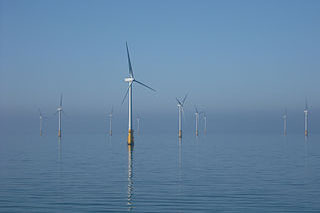An early favorite for U.S. offshore wind energy developers, New Jersey has lost its lead to other states but remains a prime location for big, 1,000 megawatt-plus projects going into the 2020s, industry experts say.
In November some 186,000 acres in federal waters were awarded in two leases to U.S. Wind Inc. and to RES Americas Developments Inc., which is now looking for the federal Bureau of Ocean Energy Management to approve RES Americas partner, Danish builder DONG Energy, to develop a project of up to 1,100 megawatts.
“We see it as a great opportunity and an emerging market,” said Carolyn Heems, development strategy director for RES Americas.
BOEM deputy director Walter Cruickshank said the agency continues to work with other maritime interests to avoid and manage potential conflicts around the lease areas, located close to busy traffic routes between New York and Delaware Bay.
 Click to view a larger BOEM map showing the offshore New Jersey wind leasing area.Besides the offshore shipping traffic separation zones south of New York, the other big issue has been the busy tug and barge route west of the lease areas, just off the New Jersey beaches. After BOEM’s maritime advisors brought up that concern, the agency used Automatic Identification System data to document the traffic volume and individual vessel paths, Cruickshank said.
Click to view a larger BOEM map showing the offshore New Jersey wind leasing area.Besides the offshore shipping traffic separation zones south of New York, the other big issue has been the busy tug and barge route west of the lease areas, just off the New Jersey beaches. After BOEM’s maritime advisors brought up that concern, the agency used Automatic Identification System data to document the traffic volume and individual vessel paths, Cruickshank said.
“Tug and barge vessel traffic is still a concern,” Cruickshank said. The American Waterway Operators warned BOEM that “they will feel a little squeezed…There’s two-way traffic there, and they feel like the shoulder is being taken away.”
The earliest proposal for New Jersey state waters, a six-turbine, 24-megawatt project proposed by Fishermen’s Energy, could be operational by the fourth quarter of 2019, chief operating officer Paul Gallagher said at an offshore wind energy forum Tuesday at Stockton University near Atlantic City.
But the $234 million plan has been mired in politics. Gov. Chris Christie, an early supporter of developing an offshore wind industry in New Jersey, expressed skepticism about the economic viability of renewable energy during his failed campaign for the Republican presidential nomination – and still has almost two years left in office.
“We may need a new governor on this one,” said James Whelan, the Democratic state senator for Atlantic City and a longtime proponent of wind development.
Rhode Island has moved to the fore, with Deepwater Wind’s similar sized pilot project under construction at Block Island, and a support base at Quonset Point in Narragansett Bay. In Maryland, U.S. Wind is looking at sites at Sparrows Point in Baltimore for a supply and manufacturing base, and Ocean City, Md., as the port to support its project offshore, said Paul Rich, the company’s project development director.
“We’ll have to design and build a lot of vessels,” Rich said. For young people entering the field, the U.S. Atlantic wind market will offer “a career’s worth of opportunity on the ocean,” he predicted.
As big projects get underway on federal leases, more manufacturing and supply chain work will take root in the U.S. and bring down the costs for wind energy, Rich and Heems said.
Whelan took up the theme of missed opportunity for his constituents. The Atlantic City region remains beset with high unemployment, and even the small Fishermen’s Energy project could bring 400 construction jobs and 20 to 25 permanent operations and maintenance positions, according to Gallagher.
“This could have been us,” Whelan said of the industry developing onshore in Maryland and Rhode Island.





